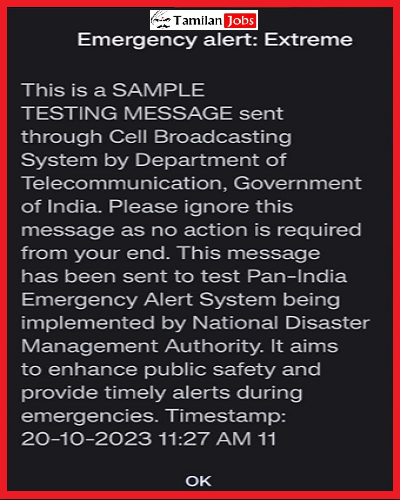India Conducts Routine Testing of National Emergency Alert System: The Indian government recently initiated another round of testing for its National Emergency Alert System, causing millions of mobile phones across the country to sound alarms. While the sudden alerts may have startled some, it’s essential to remain calm as these are part of routine tests conducted by the National Disaster Management Authority (NDMA). In this article, we’ll delve into the purpose and significance of these alerts, the technology behind them, and the future of India’s emergency alert system.

Understanding the Emergency Alerts
On a recent Tuesday morning, mobile users in India received an emergency alert from the government at approximately 11:35 AM. These alerts were delivered in the form of flash messages accompanied by an Emergency Tone. The messages were broadcasted across Android and iPhone devices. However, these alerts were nothing to be alarmed about, as they were part of a comprehensive test of India’s new emergency alert system.
Testing the Effectiveness
The primary objective of these alerts is to assess the effectiveness of the emergency alert system and identify any potential issues. The alerts were dispatched via the Cell Broadcasting System (CBS), a technology that allows mobile operators to transmit text messages to all phones in a designated area, regardless of the mobile network used. This capability makes CBS ideal for delivering emergency alerts.
Reason for Emergency Alert System
- Effectiveness Assessment: These tests are conducted to evaluate the effectiveness of the National Emergency Alert System. This assessment helps ensure that the system is reliable and can be used to reach people during real emergencies.
- Identification of Potential Problems: By conducting these tests, the National Disaster Management Authority (NDMA) aims to identify any potential issues or areas where the system may need improvement. This proactive approach helps in addressing issues before they become critical during actual emergencies.
- Cell Broadcast Technology Development: India is working on developing its own cell broadcast technology. Testing is an integral part of this process to make sure the technology can deliver alerts directly to mobile phone screens during disasters.
- Public Safety Preparedness: The primary goal of these tests is to enhance public safety and ensure timely alerts are disseminated during emergencies. These tests are part of a broader strategy to be better prepared to respond to disasters and crises.
- Periodic Testing: Conducting similar tests periodically in different regions is vital to maintain and improve the efficiency of mobile operators’ emergency warning broadcast capabilities. It allows the government to refine the system over time.
During the test, the alert message displayed “emergency alert severe” in English, Hindi and Tamil. The message was repeated twice, a few minutes apart. The NDMA also included a clear disclaimer in the message, stating that it was a test, and no action was required from recipients.
C-DOT’s Role in Developing Cell Broadcast Technology
Cell broadcast technology is a critical component of the emergency alert system. While this technology is currently sourced from foreign vendors, India’s Centre for Development of Telematics (C-DOT) is working on developing its own solution. Rajkumar Upadhyay, C-DOT’s CEO, explained that the technology is still in development but will be used by the NDMA to send alerts directly to mobile phone screens during disasters. This technology is currently being tested on Jio and BSNL networks.
Periodic Testing and Improvement
The recent emergency alert test is not an isolated incident. The Department of Telecommunications Cell Broadcasting System (DoT CBS) has announced its intention to conduct similar tests periodically in various regions of India. These tests aim to evaluate the efficiency and effectiveness of mobile operators’ emergency warning broadcast capabilities and cell broadcast systems. The data collected during these tests will help the NDMA identify areas where the system needs improvement.
Conclusion: Emergency alert tests like the recent ones in India play a crucial role in ensuring public safety and preparedness during real emergencies. The development and testing of the National Emergency Alert System, including cell broadcast technology, are essential steps in building a robust and reliable system that can effectively reach people during disasters. As technology continues to evolve, the Indian government remains committed to enhancing its emergency alert capabilities and, ultimately, protecting the safety of its citizens.

